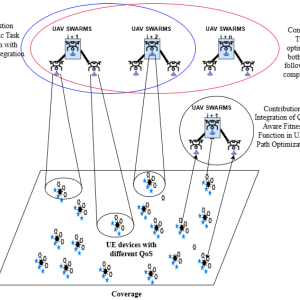The proliferation of unmanned aerial systems, while offering significant tactical advantages, also presents substantial risks when employed by adversaries. The US Army, recognizing the critical importance of neutralizing these threats, has embarked on a series of tests with L3Harris’ drone-jamming robot truck. This article delves into the intricacies of this groundbreaking technology, exploring its potential impact on future military operations and the broader implications for defense strategy.

A New Era of Drone Warfare: The Growing Threat of UAS
The rapid expansion of UAS technology has fundamentally transformed the dynamics of warfare. Drones, once the domain of high-tech military forces, have become increasingly accessible to a wide range of actors, including non-state groups and rogue nations. These systems can be deployed for surveillance, intelligence gathering, and, more concerningly, as weapons delivery platforms. The low cost, ease of deployment, and ability to operate in contested environments make drones a formidable challenge for traditional defense systems.
As drone technology has advanced, so too have the tactics and techniques used to employ them in combat scenarios. Swarming tactics, in particular, have emerged as a significant threat, overwhelming traditional air defenses with sheer numbers. The ability to launch coordinated attacks using multiple drones simultaneously complicates interception efforts and increases the likelihood of a successful strike. Given these developments, the need for effective counter-UAS (C-UAS) solutions has never been more pressing.
L3Harris’ Robot Truck: A Leap Forward in C-UAS Technology
In response to the growing drone threat, L3Harris, a leader in defense technology, has developed a sophisticated drone-jamming robot truck. This mobile platform is designed to detect, track, and neutralize UAS threats in real-time, providing a robust defense against drone incursions. The system’s capabilities are the result of years of research and development, leveraging L3Harris’ extensive expertise in electronic warfare and autonomous systems.
The L3Harris drone-jamming robot truck is equipped with state-of-the-art electronic countermeasures (ECM) that can disrupt the command and control signals of hostile drones. By jamming these signals, the system effectively renders the drones inoperable, preventing them from completing their mission. The truck’s advanced sensors can detect and identify a wide range of UAS platforms, from small quadcopters to larger fixed-wing drones, ensuring comprehensive coverage against diverse threats.
Autonomous Operation: Enhancing Battlefield Efficiency
One of the most notable features of the L3Harris drone-jamming robot truck is its autonomous operation capability. The system is designed to operate with minimal human intervention, allowing it to be deployed in high-risk environments where manned operations would be too dangerous. This autonomy is achieved through a combination of advanced artificial intelligence (AI) algorithms and sophisticated sensor fusion techniques, enabling the truck to make real-time decisions based on the threat landscape.
The autonomous nature of the system also allows for continuous 24/7 operation, providing persistent surveillance and protection against drone threats. This is particularly important in contested environments where the threat of drone attacks is constant. By reducing the need for human oversight, the L3Harris robot truck can free up valuable resources, allowing military personnel to focus on other critical tasks.
Integrated Defense: Synergy with Other C-UAS Systems
The L3Harris drone-jamming robot truck is not designed to operate in isolation but as part of an integrated defense network. The system can be seamlessly integrated with other C-UAS platforms, including kinetic interceptors, directed energy weapons, and radar systems, to provide a layered defense against drone threats. This interoperability is crucial in modern warfare, where the ability to adapt to evolving threats rapidly can mean the difference between success and failure.
By working in concert with other C-UAS systems, the L3Harris robot truck can provide a comprehensive defense against the full spectrum of drone threats. For example, while the truck’s jamming capabilities are effective against small, commercially available drones, larger, more sophisticated UAS may require kinetic solutions or directed energy weapons to neutralize. Coordinating these different systems ensures that no threat is left unaddressed.
Operational Testing and Validation: Ensuring Battlefield Readiness
Before being deployed in the field, the L3Harris drone-jamming robot truck has undergone extensive testing and validation to ensure its effectiveness in real-world scenarios. The US Army has conducted a series of rigorous tests, simulating a variety of threat environments to evaluate the system’s performance. These tests have included scenarios involving multiple drones, complex terrain, and electronic countermeasures designed to challenge the truck’s capabilities.
The results of these tests have been promising, demonstrating the system’s ability to detect, track, and neutralize UAS threats with a high degree of accuracy. The truck’s jamming capabilities have proven particularly effective, with the system able to disrupt drone operations at significant ranges. Additionally, the autonomous operation of the truck has been validated in field trials, with the system successfully navigating and operating in complex environments without human intervention.
Implications for Future Military Operations
The successful testing and deployment of the L3Harris drone-jamming robot truck have significant implications for future military operations. As drone technology continues to evolve, so too will the tactics used to counter these threats. The L3Harris system represents a significant step forward in C-UAS technology, providing a robust and adaptable solution to the growing drone threat.
In future conflicts, the ability to neutralize UAS threats will be a critical factor in determining the outcome of engagements. The L3Harris drone-jamming robot truck offers a scalable solution that can be deployed across a wide range of operational scenarios, from protecting critical infrastructure to securing forward operating bases. Its ability to operate autonomously and integrate with other C-UAS systems makes it a versatile tool in the modern military’s arsenal.
Global Implications: Strengthening Allied Defense Capabilities
The deployment of the L3Harris drone-jamming robot truck also has broader implications for global security. As drone technology proliferates, so too does the need for effective countermeasures. Allied nations facing similar threats can benefit from the lessons learned during the US Army’s testing and deployment of the system. By sharing knowledge and technology, allied forces can strengthen their collective defense capabilities and better protect against the growing drone threat.
Furthermore, the L3Harris system can be tailored to meet the specific needs of different nations, allowing for customized solutions that address unique threat environments. This flexibility is crucial in a global security landscape that is increasingly characterized by asymmetric threats and non-state actors. By providing a robust and adaptable C-UAS solution, the L3Harris drone-jamming robot truck can help allied nations maintain a technological edge over adversaries.
Technological Advancements: The Future of C-UAS Solutions
The development of the L3Harris drone-jamming robot truck is just one example of the ongoing technological advancements in the field of C-UAS. As drone technology continues to evolve, so too will the countermeasures designed to neutralize these threats. Future C-UAS systems will likely incorporate even more advanced AI and machine learning algorithms, enabling them to adapt to emerging threats in real-time.
Additionally, the integration of directed energy weapons, such as high-powered lasers, could provide a more permanent solution to the drone threat. These systems have the potential to neutralize drones at the speed of light, offering a highly effective and precise countermeasure. While still in the development stages, directed energy weapons represent the next frontier in C-UAS technology, and their integration with systems like the L3Harris robot truck could revolutionize the way drone threats are addressed.
Conclusion: A Vital Tool in Modern Warfare
The L3Harris drone-jamming robot truck represents a significant advancement in the field of counter-UAS technology. Its ability to autonomously detect, track, and neutralize UAS threats provides a robust defense against the growing drone threat. As the US Army continues to refine and deploy this system, it will undoubtedly play a crucial role in future military operations, providing a critical tool for protecting forces and infrastructure from the dangers posed by unmanned aerial systems.
The implications of this technology extend beyond the battlefield, offering valuable lessons for allied nations and paving the way for future innovations in C-UAS solutions. As drone technology continues to evolve, the need for effective countermeasures will only grow, and the L3Harris drone-jamming robot truck is poised to be at the forefront of this critical area of defense technology.










